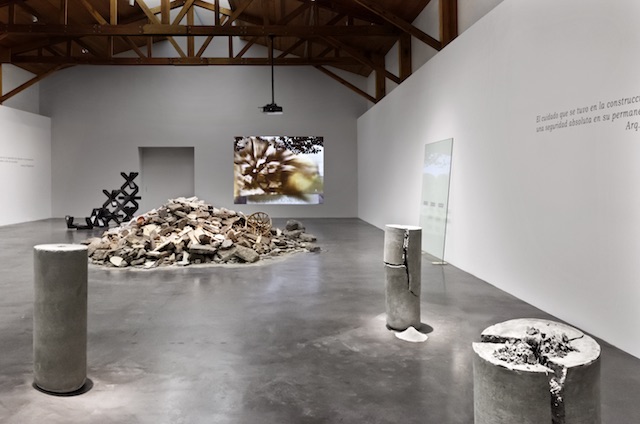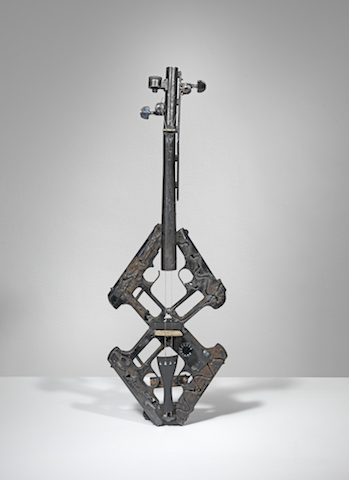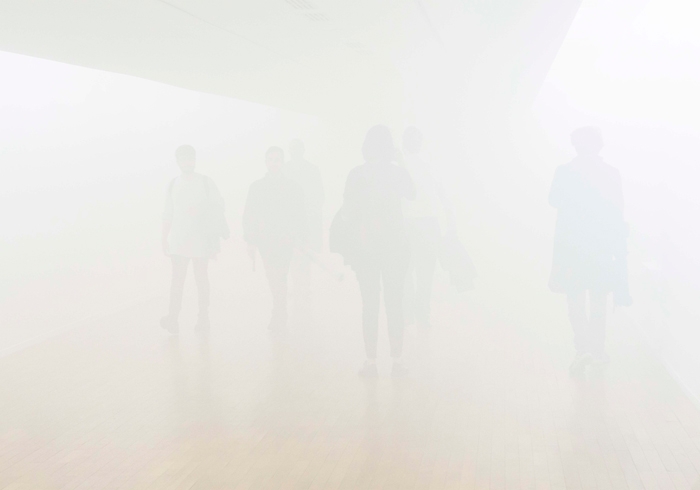Monsters are demonstrative – it’s in the etymology – and their current incarnations in Mexico display an instinctive knack for the spectacle of violence. Since the start of the catastrophic ‘war on drugs’ initiated by former president Felipe Calderón in 2006 when he sent thousands of troops and federal police into his home state of Michoacán, over 200,000 individuals have been killed as the cartels battle among themselves for territory (and control of supply routes to the United States) while a weakened military tries to keep them in check. The ruthless competition between cartels extends into the production of images; each has a strong sense of how to construct a striking visual message, and never stops striving for greater effect: faces stitched onto footballs, bodies dangling from bridges, severed heads rolled out onto dancefloors. Even the language employed on narcomantas, banners that display warnings to rivals, and in narcocorridos, ballads that versify crimes into lore, tends to be figurative and allusive, and part of a growing vernacular. The more I read about what is happening in my country, the more I wonder whether art should even attempt to capture the monstrous and unspeakable when real-life horror far outdoes any construct.
The more I read about what is happening in my country, the more I wonder whether art should even attempt to capture the monstrous and unspeakable when real-life horror far outdoes any construct
Every day the news serves up gruesome reports of beheadings and maimings, of a violence and brutality so theatrical that even the depiction of severed body parts in Francisco Goya’s Disasters of War (1810–20) seems restrained. Indeed, the dismemberments of Hieronymus Bosch and Goya are nothing compared to the real images of human mutilation circulated in the Mexican media. Narco violence is not art, yet its graphic mises-en-scène could similarly be read as allegories of great sociopolitical disarray, and the decapitated heads as metaphors for a country without any real leadership.
Two scenarios from the month of April alone illustrate the horror. Four weeks after they went missing in Jalisco, three film students were found tortured, murdered and dissolved in acid. Investigators say they were mistaken for members of a rival cartel by the Jalisco New Generation Cartel. And in an abandoned vehicle in Cancún, police discovered the corpses of five men who had been tortured to death, two decapitated, with their hearts ripped out. The heads were in a separate bag, hearts shoved into mouths sewn shut with wire.
Narco violence is not art, yet its graphic mises-en-scène could similarly be read as allegories of great sociopolitical disarray, and the decapitated heads as metaphors for a country without any real leadership
The skulls and bleeding hearts that are ubiquitous symbols in Mexican iconography – from Aztec human sacrifice and tzompantli (skull racks) to the Day of the Dead to the contemporary cult of the Santa Muerte (Holy Death, a skeleton in robes who is patron saint of the disenfranchised and the Mexican underworld) – have always formed part of a metaphysics premised on reverence for death and rebirth. Yet the disembodied heads of today, though serving as a warning to others, signal nothing more than chaos and collapse. The state has lost its prerogative, its monopoly on violence replaced by the anarchic brutality of ‘narco states’ locked in savage battle.
So where does this leave art? Among those Mexican artists who have given voice to the malaise, Eduardo Abaroa’s Destrucción Total del Museo de Antropología (2012) imagines the towering monoliths of Mexico’s ancient gods reduced to rubble, in the process deconstructing the efforts of modern politicians to position themselves as the inheritors of those indigenous cultures their policies betrayed. Alfonso Piloto Nieves sculpts ghastly heads and torsos out of found detritus, as if evil and depravity were endlessly recycled, and all that changes is the form. More optimistically, Pedro Reyes takes guns decommissioned from the drug cartels and transforms them into shovels for planting trees around the world, in the case of Palas por Pistolas (Guns for Shovels, 2007), or into musical instruments, in Disarm (2013).

One of the boldest artists to engage with the crisis has been Teresa Margolles. Her work is deeply inhabited by the monstrous, signified at a remove by the victims’ remains. Originally from Culiacán, home to the once all-powerful Sinaloa cartel headed by Joaquín ‘El Chapo’ Guzmán, Margolles trained as a forensic pathologist. From the start, the morgue served as both laboratory and studio – ‘a morgue for me is a thermometer of a society’, she once said – but with the rise in violence across Mexico she moved into the streets, which provided just as many cadavers. Here too the human body becomes a site of transformation, but Margolles transmutes the evidence into something haunting and ethereal. Gruesome subjects are stripped of theatricality, yet there endures a material relationship with the source.
From afar, Papeles (2003) appears to be an arrangement of marbled papers, which upon closer inspection reveal murky emulsions, created by immersion in the water used to wash a corpse following autopsy, one sheet per body. In some cases, a bit of hair or fat has adhered itself. Arranged into rows on the wall, the papers form an assembly of anonymous postmortem portraits displaying different temperatures of red. Although the blood has stopped circulating, it’s hard not to imagine a few swirls of life, the same patterns and tapestries as those on slides under a microscope.
In Vaporización (2001) spectators enter a saunalike space only to discover the dense mist is composed of particles of water used to rinse corpses in a Mexico City morgue. The dead inhabit the air as they are breathed in by visitors, whose own outlines are scarcely visible. In that space the living, too, are threatened with disappearance (along with the murdered, there are at least 30,000 reported missing in Mexico). Similarly, En el Aire (2003) fills the space with shimmering bubbles produced from the liquid used to disinfect dead bodies. Each bubble – fragile, erratic, ephemeral – represents a person. These two installations are at once transcendent and perverse; in life, these individuals would have dwelled on the margins of society, distant from the culture represented by art galleries; in death, something of them, sanitised and distilled, drifts around these spaces.

This is a far cry from the dispassionate approach to Mexican horror adopted by some commentators abroad. In the London-based collective Forensic Architecture’s The Ayotzinapa Case: A Cartography of Violence (2017), diagrams and coolly laid-out graphs map the fate of 43 students who in September 2014 were attacked and forcibly disappeared. Within the bare visuals reside aesthetic decisions – colours, angles, the spatial distribution of the information. Yet in a country where a staggering 99 percent of crimes go unpunished, according to the Mexico Global Impunity Index published by the Universidad de las Américas, it might seem futile to a Mexican artist to present their reality in such dry, technical terms, seemingly devoid of judgment and emotion.
Today, a major socioeconomic breakdown in Mexico has given rise to new manifestations of the monstrous, to visions of physical fragmentation that evoke the finitude of our existence
In cinema, a documentary approach feels more apposite than any fiction. Everardo González’s Devil’s Freedom (2017), a nightmarish chronicle of the drug and state violence, is an impressive example of this negotiation between disclosure and concealment. The title refers to something everyone knows: Mexico is a country where evil roams freely, and the scenes unfold under the pall of a perpetual twilight. Here, we meet victims, relatives of victims and perpetrators – hitmen, kidnappers, police and military who have agreed to speak about their crimes to the camera. Anonymity is guaranteed by a mask, and everyone in the film wears the same flesh-coloured balaclava with holes for eyes, mouth and nose. At first this decision seems theatrical and contrived, like lucha libre costume stripped of its adornment, yet this paring-down of visuals grants the film a genuine complexity in which archetypes are dismantled. Victims and offenders are made to share the same face, which before long inspires in the viewer an all-encompassing empathy.
After the conquest of Mexico, the transition from Aztec cosmology to Catholic faith was eased by the convergence of a ‘theatre of death’ present in both religions. Mexican Baroque emerged from the spiritual crisis that set in after the long, fraught process of subjugation that followed, and the altarpieces and church facades teemed with hybrids and grotesques, mutations and metamorphoses, excess and fluidity. The monolithic sculptures of pre-Hispanic civilisations – signs of a certain stability – were replaced by an art that favoured movement over stasis, agility over volume: more fluid and volatile. Today, a major socioeconomic breakdown in Mexico has given rise to new manifestations of the monstrous, to visions of physical fragmentation that evoke the finitude of our existence.
Rather than reiterate the spectacle of a violence divorced from metaphysics – any attempt would fall short – certain Mexican artists have chosen to engage instead with materiality. Adopting a more forensic or literal approach to matter, they break it down to wrest different meanings from the destruction, distillation or recombination of its elements. This contemporary form of hybridity, which incorporates conflicting energies and a sense of the fugitive and mutable, may seem worlds apart from the transubstantiation of matter pushed by the cartels; and yet everything within this panorama is under constant threat of transformation, caught up in an inescapable, annihilating, flow.
From the Summer 2018 issue of ArtReview
